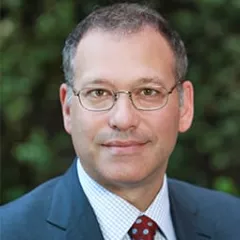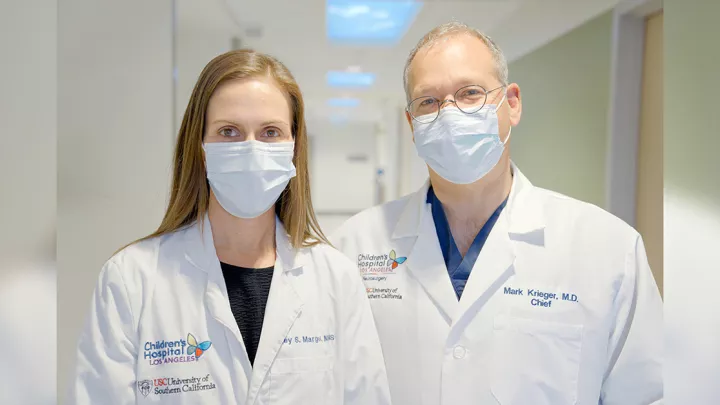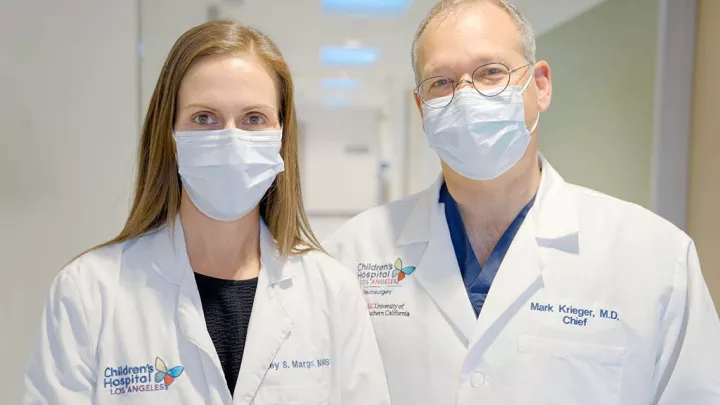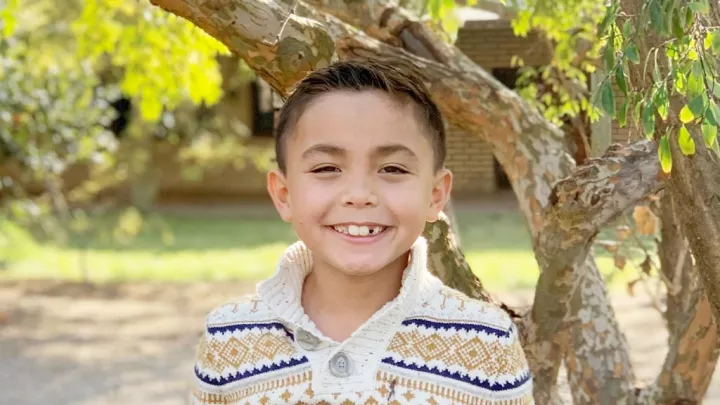
Mark D. Krieger, MD
Mark D. Krieger, MD joined the Children’s Neurosurgery Center in 2002 and is currently the Senior Vice President and Surgeon-in-Chief at CHLA and the Billy and Audrey Wilder Neurosurgery Chair.
He joined CHLA two decades ago as a fellow in pediatric neurosurgery. He became Chief of the Division of Neurosurgery in 2012 and Associate Chief of the Department of Surgery in 2017 and served as interim Surgeon-in-Chief for the Department since June 2018. He served as CHLA’s Chief of Staff for six years with oversight for more than 750 physicians for their medical staff responsibilities, credentialing and recredentialing processes. He has been a member of the Board of Trustees for eight years and is also a current member of the Board for the Children’s Hospital Los Angeles Medical Group.
Dr. Krieger completed his undergraduate studies at Harvard University and holds a degree in medicine from Columbia University. Nationally, he is a fellow of the American College of Surgeons, a Director of the American Board of Pediatric Neurosurgery, and Chair of the Pediatric Joint section of the American Association of Neurological Surgeons and the Congress of Neurological Surgeons, the largest organization of pediatric neurosurgeons in the world. He has authored more than 110 peer review publications and made 250 national and international presentations.
He has advanced neurosurgery research and treatment for children. One of his recent efforts garnered nationwide coverage as he used an innovative surgery to place implants directly on the brainstem to help children born without auditory nerves detect sound.
Brain and spinal tumors; Chiari malformations; Intracranial cysts; Hydrocephalus
Education
Columbia University, College of Physicians and Surgeons
Los Angeles County-University of Southern California Medical Center; Neurosurgery
Los Angeles County-University of Southern California Medical Center; Neurosurgery
Children's Hospital Los Angeles; Pediatric Neurosurgery
Accomplishments
American Board of Pediatric Neurosurgery and American Board of Neurological Surgery
American Society of Pediatric Neurosurgeons; American Association of Neurological Surgeons; Congress of Neurological Surgeons
Publications
Publications
- The association between dental health and procedures and developing shunt infections in pediatric patients. Moazzam AA, Nehrer E, Da Silva SL, Polido JC, Arakelyan A, Habibian M, Krieger MD., J Neurosurg Pediatr. 2014 Sep 12:1-6. [Epub ahead of print]
- What is the risk of infecting a cerebrospinal fluid-diverting shunt with percutaneous tapping? Spiegelman L, Asija R, Da Silva SL, Krieger MD, McComb JG., J Neurosurg Pediatr. 2014 Oct;14(4):336-9. doi: 10.3171/2014.7.PEDS13612. Epub 2014 Aug 8.
- Deep brain stimulation evoked potentials may relate to clinical benefit in childhood dystonia. Bhanpuri NH, Bertucco M, Ferman D, Young SJ, Liker MA, Krieger MD, Sanger TD., Brain Stimul. 2014 Sep-Oct;7(5):718-26. doi: 10.1016/j.brs.2014.06.003. Epub 2014 Jun 25.
- A retrospective analysis of recurrent intracranial ependymoma. Antony R, Wong KE, Patel M, Olch AJ, McComb G, Krieger M, Gilles F, Sposto R, Erdreich-Epstein A, Dhall G, Gardner S, Finlay JL., Pediatr Blood Cancer. 2014 Jul;61(7):1195-201. doi: 10.1002/pbc.24996. Epub 2014 Feb 24.
- PID1 (NYGGF4), a new growth-inhibitory gene in embryonal brain tumors and gliomas. Erdreich-Epstein A, Robison N, Ren X, Zhou H, Xu J, Davidson TB, Schur M, Gilles FH, Ji L, Malvar J, Shackleford GM, Margol AS, Krieger MD, Judkins AR, Jones DT, Pfister SM, Kool M, Sposto R, Asgharazadeh S., Clin Cancer Res. 2014 Feb 15;20(4):827-36. doi: 10.1158/1078-0432.CCR-13-2053. Epub 2013 Dec 3.
Research
Pediatric brain tumors are difficult to understand because they behave differently than adult tumors. The overarching goal our research is to make surgery obsolete. We want to cure these brain tumors, without causing injury to the child in the process. Twenty years ago, children with brain tumors received high doses of radiation therapy, which would kill the tumor, but would also cause significant negative impact to the patient’s cognitive ability. Today, we strive to find the least toxic therapy that we can give these kids that will cure these tumors at a high rate, but not cause damage to the brain.
This involves looking at differentiating types of tumors and figuring out the best therapies that are tailored to each type of tumor. This is more of a personalized medicine approach. We try to target surgery, chemotherapy, radiation therapy to treat our patients in the best way possible based on each child’s specific disease.
One new area is functional neurosurgery, which looks at the brain as a collection of electrical or chemical circuits of the brain that helps us learn and develop as individuals. Sometimes when these circuits go awry, they can cause disease. We are just getting started on how to modulate these pathways so we can help our patients live full and productive lives. We are starting a surgical epilepsy program so tailor surgical procedures to patients that have seizures and are not responding to medication. We are also starting up a movement disorder clinic. A lot of our patients are born with cerebral palsy or spasticity where they have a hard time moving and they are actually locked in their bodies. They may have a normal brain, but this movement disorder means they are unable to move and express themselves. We’re learning about this by putting electrodes to the brain and stimulating different parts of the brain and modulating the pathways of these circuits.
We are trying to get an understanding of how the brain works essentially. We are trying to see the how the different areas of the brain interact with, and impact each other and trying to find ways to modulate those pathways to actualize the potential of all of our patients. For example, if a child’s brain doesn’t function properly to allow a child’s body to move in normal ways, we’re trying to change the modulation of the different pathways so that the body is free to move normally.
We have a large team of neuro-oncologists, neuro-patholigists, neuro-radiologists, neurologists and psychiatrists and other health care professionals who work together to take care of our patients and we have been able to achieve high results. Our goal is to bring our physicians together to be able to solve issues and create opportunities to create hope. Some of these tumors that were incurable 10 years ago now have a high rate of cure. One of the most common malignant types of tumor that had a 50% survival rate now has a better than 90% survival rate.
Visit the Krieger Laboratory.
Media
LA Times - Flintridge Guild members tour CHLA
Yahoo!Finance- $2 Million Gift to Spur Research into Brain Tumors at Children's Hospital Los Angeles
The Hollywood Reporter- Proder Nigel Lythgoe Pays Homage to The Doctor Who Saved His Baby Grandson
Los Angeles Times- Video: Watch this boy born deaf hear music for the first time
CBS News- Deaf Montreal boy gains hearing after experimental surgery
People.com - "Twin Marias" celebrate quinceañera in Los Angeles
Press Releases
Hollywood Legends Give Back to the Kids at Children’s Hospital Los Angeles
CHLA Blog
After Brain Surgery and Chemotherapy, Florence Gets a Fresh Start
Surgeon Takes Aim at a Lethal Childhood Brain Tumor
(Brain) Pictures are Worth a Thousand Cures
Children's Hospital Los Angeles Celebrates at Gala: 'Once Upon a Time'


